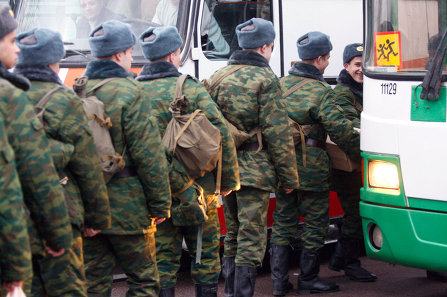
Young Dagestanis Struggle to Be Drafted Into Russian Military
Publication: Eurasia Daily Monitor Volume: 12 Issue: 200
By:

Many young Dagestani men wish to serve as conscripts in the Russian army, but are rejected on the grounds of their ethnic identity. In the fall of 2015, Moscow ordered the authorities to supply 1,500 conscripts for the Russian armed forces. During this past spring’s military draft, Dagestan supplied 1,300 conscripts to the country’s armed forces. Overall, 2,800 conscripts comprise altogether only about 7 percent of the estimated 40,000 young men in the republic who are suitable for the military draft (Kavkazskaya Politika, October 27).
The Russian Armed Forces draft young men twice a year, in the spring and the fall. All men aged 18 to 27 are eligible and, in fact, obliged to serve conscript military service for one year. Compulsory military service, however, stopped working in the North Caucasian republics. Chechens have practically never served in the Russian army in the post-Soviet period thanks to the two Russian-Chechen wars and the ongoing tensions between ethnic Chechens and ethnic Russians. In 2009, the military draft was also drastically cut in the other North Caucasian republics, particularly in Dagestan. Russian military officials have noted security concerns, citing the ongoing insurgency in the North Caucasus and lack of discipline among North Caucasian conscripts as the primary reasons for the decision. Dagestan, with a population of around three million people, is not only the largest republic in the North Caucasus, but also has the highest birthrate, creating a so-called “youth bulge” in the republic.
Young men from the North Caucasus want to serve in the Russian army for a variety of reasons, perhaps the most important being the desire to improve their life prospects and obtain a stable standard of income. Government and municipal jobs are closed to those men who have not served in the military or have not received a lawful excuse for not serving, such as on medical grounds. In addition, private sector jobs are only partially available to those who have not served in the military.
In a recent interview with the Kavkazskaya Politika website, a 20-year-old Dagestani identified only as Jabrail said that after he was turned down by the military draft commission once again, he asked his friend to find out whether he could bribe his way into the Russian military. The bribe to serve in the army allegedly came to nearly $1,000. Prior to 2008, 15,000–20,000 Dagestanis were drafted every year. In 2010, the military draft dropped to about 8,000; and in 2011, only about 1,000 men from the republic were drafted. A Dagestani military official who deals with the military draft, Yavnus Jambalaev, told Kavkazskaya Politika that they do not draft people who do not wish to serve in the armed forces. Jambalaev claimed fewer people are being drafted because “technology has become so complicated” that only well-prepared individuals can serve in the armed forces (Kavkazskaya Politika, October 27).
The Stavropol region, which happens to have a predominantly ethnic-Russian population, apparently has brighter potential draftees than Dagestan. This fall, Stavropol is sending 3,100 conscripts into the Russian armed forces (Stavropolye.tv, October 1), twice as many as Dagestan, even though the pool of potential draftees in Stavropol is about 3.5 times smaller than that of Dagestan (Voennoe.rf, March 2).
Many young Russians prefer to avoid the draft: indeed, the authorities regularly threaten potential draftees who dodge the draft with criminal prosecution (Magoblproc.ru, February 18, 2014). The exact number of draft evaders is secret, which suggests that it is fairly large, although officials have claimed there are only 6,000 of them across Russia (Rosbalt, April 2, 2014). Some sources have alleged that the military service has become much more popular among young Russians over the past two years due to the patriotic upsurge in the country (Moskovsky Komsomolets, October 22).
Other republics of the North Caucasus also supply only handfuls of conscripts compared to other Russian regions. The greater the proportion of ethnic Russians in a republic, the more young men are drafted from that federal entity. For example, Ingushetia has almost no ethnic Russians and supplied only 400 conscripts this fall. Karachaevo-Cherkessia, which has roughly the same population as Ingushetia but a large ethnic-Russian population, is sending 850 conscripts. Kabardino-Balkaria has a population twice as large as Karachaevo-Cherkessia but a smaller ethnic Russian population, so it is sending only 600 men to the Russian armed forces this fall. Approximately 15,000 potential conscripts exist in Kabardino-Balkaria. Chechnya is reportedly preparing to send nearly 800 conscripts into the Russian army, although it is unclear where exactly they will serve—inside Chechnya, as in the past, or in other Russian regions (Kavkazweb.biz, October 22).
The bizarre situation surrounding the draft in the North Caucasus has implications beyond military service. Above all, Moscow is reducing the involvement of young North Caucasians with the Russian state and diminishing their career opportunities. This could be ameliorated with the expansion of the private sector in the economy of the North Caucasus or changing laws to allow people to work for the government. But Moscow appears to have a conscious policy of excluding North Caucasians from the Russian polity.




